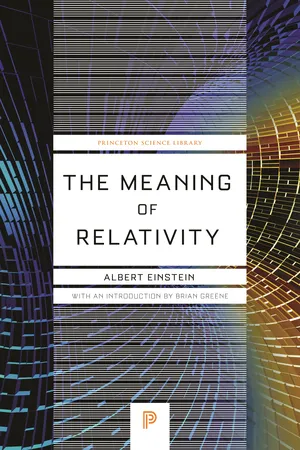![]()
APPENDIX II
RELATIVISTIC THEORY OF THE NON-SYMMETRIC FIELD
BEFORE starting with the subject proper I am first going to discuss the “strength” of systems of field equations in general. This discussion is of intrinsic interest quite apart from the particular theory presented here. For a deeper understanding of our problem, however, it is almost indispensable.
ON THE “COMPATIBILITY” AND THE “STRENGTH” OF SYSTEMS OF FIELD EQUATIONS
Given certain field variables and a system of field equations for them, the latter will not in general determine the field completely. There still remain certain free data for a solution of the field equations. The smaller the number of free data consistent with the system of field equations, the “stronger” is the system. It is clear that in the absence of any other viewpoint from which to select the equations, one will prefer a “stronger” system to a less strong one. It is our aim to find a measure for this strength of systems of equations. It will turn out that such a measure can be defined which will even enable us to compare with each other the strengths of systems whose field variables differ with respect to number and kind.
We shall present the concepts and methods involved here in examples of increasing complexity, restricting ourselves to four-dimensional fields, and in the course of these examples we shall successively introduce the relevant concepts.
First example: The scalar wave equation*
Here the system consists of only
one differential equation for
one field variable. We assume
ϕ to be expanded in a Taylor series in the neighborhood of a point
P (which presupposes the analytic character of
ϕ). The totality of its coefficients describes then the function completely. The number of
nth order coefficients (that is, the
nth order derivatives of
ϕ at the point
P) is equal to
(abbreviated
), and all these coefficients could be freely chosen if the differential equation did not imply certain relations between them. Since the equation is of second order, these relations are found by (
n − 2) fold differentiation of the equation. We thus obtain for the
nth order coefficients
conditions. The number of
nth order coefficients remaining free is therefore
This number is positive for any n. Hence, if the free coefficients for all orders smaller than n have been fixed, the conditions for the coefficients of order n can always be satisfied without changing the coefficients already chosen.
Analogous reasoning can be applied to systems consisting of several equations. If the number of free nth order coefficients does not become smaller than zero, we call the system of equations absolutely compatible. We shall restrict ourselves to such systems of equations. All systems known to me which are used in physics are of this kind.
Let us now rewrite equation (1). We have
where z1 = +6.
If we restrict ourselves to large values of
n, we may neglect the terms
etc. in the parenthesis, and we obtain for (
1)
asymptoticallyWe call z1 the “coefficient of freedom,” which in our case has the value 6. The larger this coefficient, the weaker is the corresponding system of equations.
Second example: Maxwell’s equations for empty space
ϕik results from the antisymmetric tensor ϕik by raising the covariant indices with the help of
These are 4 + 4 field equations for six field variables. Among these eight equations, there exist two identities. If the left-hand sides of the field equations are denoted by Gi and Hikl respectively, the identities have the form
In this case we reason as follows.
The Taylor expansion of the six field components furnishes
coefficients of the nth order. The co...













